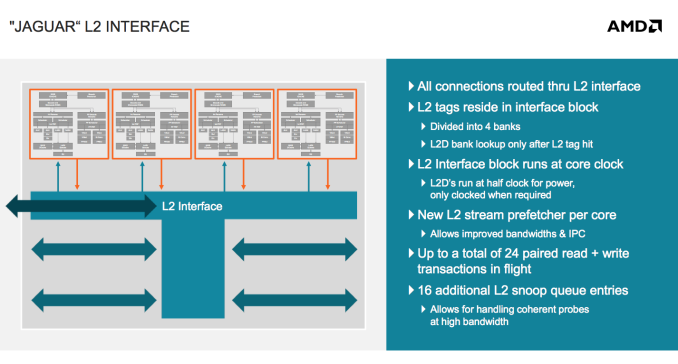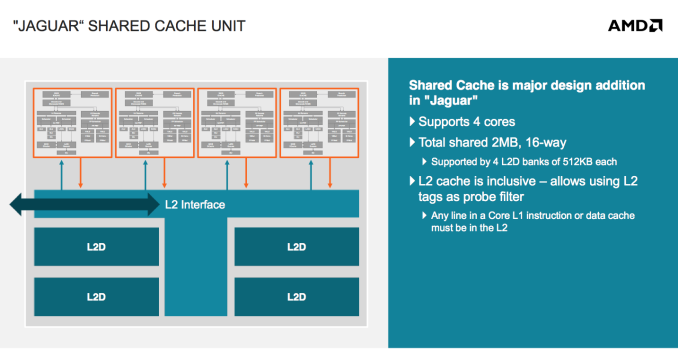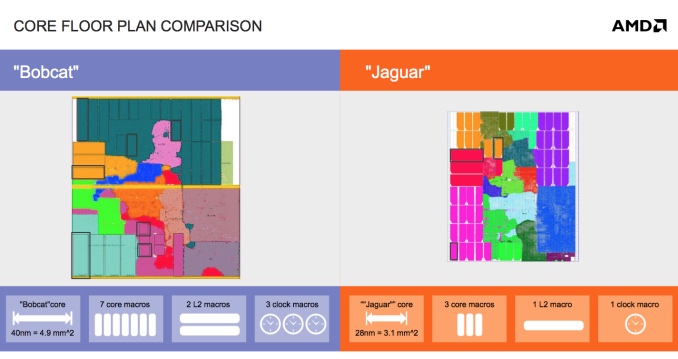AMD’s Jaguar Architecture: The CPU Powering Xbox One, PlayStation 4, Kabini & Temash
by Anand Lal Shimpi on May 23, 2013 12:00 AM ESTCompute Unit
Bobcat was pretty simple from a multi-core standpoint. Each Bobcat core had its own private 512KB L2 cache, and all core-to-core communication happened via a bus interface on each of the cores. The cache hierarchy was exclusive, as has been the case with all of AMD’s previous architectures.
Jaguar changes everything. AMD defines a Jaguar compute unit as up to four cores with a single, large, shared L2 cache. The L2 cache can be up to 2MB in size and is 16-way set associative. The L2 cache is also inclusive, a first in AMD’s history. In the past AMD always implemented exclusive caches as the inclusive duplicating of L1 data in L2 meant a smaller effective L2 cache. The larger shared L2 cache is responsible for up to another 5-7% increase in IPC over Bobcat (totaling ~22%).
AMD’s new cache architecture and lower latency core-to-core communication within a Jaguar compute unit means an even greater performance advantage over Bobcat in multithreaded workloads:
| Multithreaded Performance Comparison | ||||||||||||||||
| # of Cores | Cinebench 11.5 (Single Threaded) | Cinebench 11.5 (Multithreaded) | ||||||||||||||
| AMD A4-5000 (1.5GHz Jaguar x 4) | 4 | 0.39 | 1.5 | |||||||||||||
| AMD E-350 (1.6GHz Bobcat x 2) | 2 | 0.32 | 0.61 | |||||||||||||
| Advantage | 100% | 21.9% | 145.9% | |||||||||||||
The L1 caches remain unchanged at 32KB/32KB (I/D cache) per core.
Physical Layout and Synthesis
Bobcat was AMD’s first easily synthesized CPU core, it was a direct result of the ATI acquisition years before. With Jaguar, AMD made a conscious effort to further reduce the number of unique macros required by the design. The result was a great simplification, which helped AMD port Jaguar between foundries. There’s of course an area tradeoff when moving away from custom macros to more general designs but it was deemed worthwhile. Looking at the results, you really can’t argue. A single Jaguar core measures only 3.1mm^2 at 28nm compared to 4.9mm^2 for a 40nm Bobcat.














78 Comments
View All Comments
GuMeshow - Friday, May 24, 2013 - link
The Embedded G-Series SOCs seem to be exactly Kabini + ECC memory enabled (ex: GX-420CA and A5-5200). This will probably be the cheapest way to get ECC enabled and better performance then Atom, next step up would be Intel S1200KPR + Celeron G1610?.I've been thinking of putting together a Router/Firewall/Proxy/NAS combo ...
R3MF - Thursday, May 23, 2013 - link
HSA?Spoelie - Thursday, May 23, 2013 - link
Is it just me or does the shared L2 cache merely enable the same scaling to 4 cores as bobcat had to 2 cores? There is no "massive benefit" as alluded to in the numbers or discussion.Bobcat has for one thread 0.32 and for two threads 0.61, or a scaling of 95%. (0.64 perfect scaling)
Jaguar has for one thread 0.39 and for four threads 1.50, or a scaling of 96% (1.56 perfect scaling)
The 1% difference could easily be a result of score rounding. I see that a four core bobcat would probably scale worse than jaguar, but the percentages chosen in the table are a bit misleading.
Spoelie - Thursday, May 23, 2013 - link
Of course, drawing such conclusions from a single benchmark is dangerous. If other benchmarks exhibit more code/data sharing and thread dependencies than Cinebench, their numbers might show a more appreciable scaling benefit from the shared L2 cache.tipoo - Thursday, May 23, 2013 - link
I wonder how this compares to the PowerPC 750, which the Wii U is based off of. The PS4 and One being Jaguar based, that would be interesting.aliasfox - Thursday, May 23, 2013 - link
Wii U uses a PPC 750? Correct me if I'm wrong, but the PPC 750 family is the same chip that Apple marketed as the G3 up until about 10 years ago? And IIRC, Dolphin in the GameCube was also based on this architecture?Back in the day, the G3 at least had formidable integer performance -clock for clock, it was able to outdo the Pentium II on certain (integer heavy) benchmarks by 2x. Its downfall was an outdated chipset (no proper support for DDR) and the inability to scale to higher clockspeeds - integer performance may have been fast, but floating point performance wasn't quite as impressively fast - good if the Pentium II you're competing against is nearly the same clock, bad when the PIII and Core Solos are 2x your clockspeed.
Considering the history of the PPC 750, I'd love to know how a modern version of it would compare.
tipoo - Thursday, May 23, 2013 - link
Yes, the Gamecube, Wii, and Wii U all use PowerPC 750 based processors. The Wii U is the only known multicore implementation of it, but the core itself appears unchanged from the Wii, according to the hacker that told us the clock speed and other details.tipoo - Thursday, May 23, 2013 - link
And you're right, it was good at integer, but the FPU was absolutely terrible...Which makes it an odd choice for games, since games rely much more on floating point math than integer. I think it was only kept for backwards compatibility, while even three Jaguar cores would have been better performing and still small.The Nintendo faithful are saying it won't matter since FP work will get pushed to the GPU, but the GPU is already straining to get even a little ahead of the PS360, plus not all algorithms work well on GPUs.
tipoo - Thursday, May 23, 2013 - link
Also barely any SIMD, just paired singles. Even the ancient Xenon had good SIMD.tipoo - Thursday, May 23, 2013 - link
Unchanged on the actual core parts I mean, obviously the eDRAM is different from old 750s.